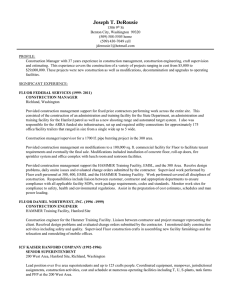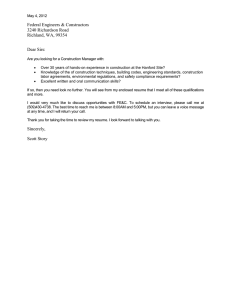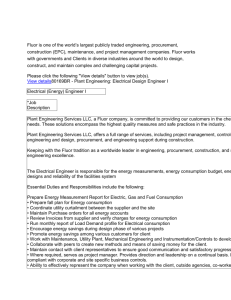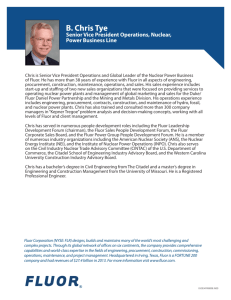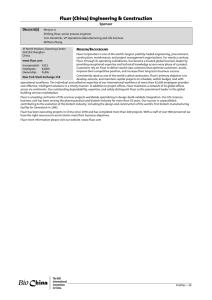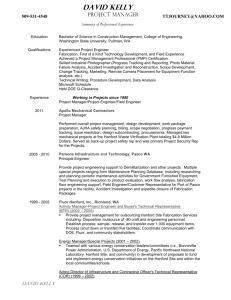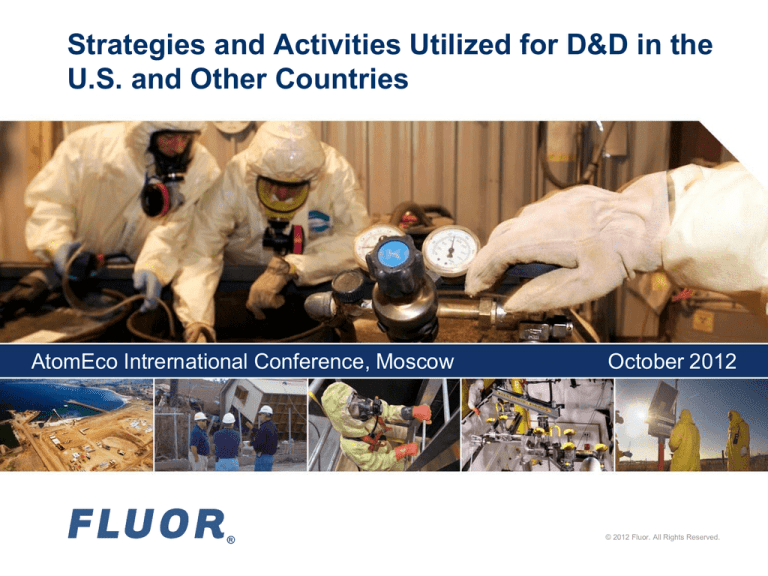
Strategies and Activities Utilized for D&D in the
U.S. and Other Countries
AtomEco Intrernational Conference, Moscow
October 2012
© 2012 Fluor. All Rights Reserved.
Fluor Corporation Overview
Fluor is one of the world’s leading publicly
traded engineering, procurement, construction,
maintenance, and project management
companies
2011 Revenue: $23.4 billion
2011 New Awards: $26.9 billion
Current Backlog: $39.5 billion
International: 75%
Energy &
Chemicals
Power
Global
Services
Government
#124 in the FORTUNE 500 in 2011
Industrial &
Infrastructure
Over 1,000 projects annually, serving more
than 600 clients in 66 different countries
Offices in 28 countries on 6 continents
Revenue by Business Segment
Celebrating 100 years in 2012
Workforce of over 42,000 men and women executing projects globally
1
Fluor’s Diversified Businesses
Energy & Chemicals
Chemicals
Downstream
Industrial &
Infrastructure
Government
Alternative Power Nuclear
Decommissioning
Commercial &
Institutional
Offshore
Solutions
Healthcare
Upstream
Life Sciences
ICA Fluor
Manufacturing
Mining & Metals
Telecom
Transportation
Water
Power
Solid-Fueled
Gas-Fueled/IGCC
Logistics &
Construction
Renewable
Energy
Contingency
Operations
Commercial
Nuclear
Services
Environmental
Compliance
Clients:
DOD
Power Services
DOE
DHS
DOL
NASA
UK Nuclear
Decommissioning
Authority
Global Services
Operations &
Maintenance
Construction
Equipment &
Tools
Staffing
2
Fluor’s Safety Performance
Total Case Incident Rate (TRIR) based on
more that 250 million hours worked
3
Nuclear Decommissioning
5 sample projects:
K Basin Spent Nuclear Fuel & Sludge Removal Project –
U.S. DOE, Hanford 1996-2006
Portsmouth Decommissioning Project – U.S. DOE, Ohio
2011-Present
Fernald Environmental Remediation Project – U.S. DOE
Ohio 1998-2007
Savannah River Nuclear Site (SRS) – U.S. DOE, South
Carolina 2008-Present
International Remediation Projects – U.K. and Russia,
2004-2008
Workers using video equipment at
K-Basins, DOE
Hanford, Washington
4
Hanford K-Basins – High Hazard Project
95 percent of the radioactivity in Hanford’s reactor area Over 2.11 million kilograms of deteriorated and
damaged fuel removed, washed, dried, containerized,
and stored - Approximately 2.0 x 106 TBq
Hanford Site - 1517 km2
5
Hanford Project - K Reactor Fuel Basins
Highly radioactive fuel and
debris handling tool
Highly corroded metal
uranium fuels in a canister
Disintegrated fuel in
containers
105,000 fuel assemblies covered with
miscellaneous contaminated debris
6
Hanford Project - K Basin – Challenges Met
K-Basins as
it appeared
in 2000
2000
2007
Six engineered containers of sludge (46 m3) in
K-Basins while awaiting transfer & treatment
135.4 metric tons of debris, racks and
canisters removed from K-Basin
7
Hanford Project Management - Sludge Transfer
Booster Station and Hose
Transferred approximately 38 m3 of highly radioactive sludge from engineered containers in K
East to engineered containers in K West via approximately 0.8 km long hose-in-hose system
with 4 booster pump stations
8
Portsmouth Gaseous Diffusion Plant D&D
D&D of 415 buildings at Portsmouth Gas Diffusion
Plant formally used to enrich uranium
hexafluoride (UF6)
Fluor is responsible for performing the
decontamination and demolition (D&D) of three
massive uranium enrichment process buildings
– each covering more than 12-hectares
10-year, $2.1 billion contract awarded in 2011
1,600+ employees
1,500-hectare site
Fluor is providing economic development
advisors to bring new industry to the depressed
Portsmouth region
9
Fernald Environmental Remediation Project
Converted a 425-hectare U.S. DOE Fernald Uranium
Processing Complex to a Nature Reserve
Reduced original clean-up schedule by 12 years
and project cost by US $7.8 billion (original
schedule was 27 years and $12.2 billion).
Dismantled over 300 buildings, including 250
radiologically-contaminated buildings and
structures.
Excavated and shipped 1 million tons of waste
from 6 waste pits.
Removed 31 million pounds of uranium product
Disposed of 2.0 million cubic meters of
contaminated soil, including shipping 1.4 million
cubic meters off site.
Remediated a 90-hectare uranium-contaminated
groundwater plume.
DOE Fernald site, Ohio United States
Two silos and processing facilities
10
Sellafield – Resource Enhancement Contract
Resource Enhancement contract to improve cleanup and decommissioning
performance
Contract with British Nuclear Group
(BNG)
2-year contract focused on improving
cleanup and decommissioning.
Scope approx. $400 million/year out
of $1.2 billion Site budget.
Seconded 24 Senior Fluor employees
into site management team
Head of B30 ponds
Head of low-level disposal facility
Head of project controls
Reduced Site Lifetime Plan costs by
several hundred million dollars and
accelerated baseline schedules
Sellafield Site
11
Sellafield - B30 Sludge Inventory
350 tons of degraded fuel
1,204m3 sludge inventory
1,234 containers in the pond
12
Northern Dimension Environmental Partnership,
Russia
Provided Russia with program
management expertise and lessons
learned from U.S. nuclear
decommissioning projects
Project funded by European Bank for
Reconstruction and Development
(EBRD) and managed by Russian
Academy of Sciences, Nuclear Safety
Institute.
Fluor specialists were fully integrated
into project teams and worked hand in
hand with Russian experts.
Multi-purpose Submarine being dismantled
Introduced best practice processes used
for strategic planning.
Andreeva Bay, Murmansk Region
13
Management Objectives for Decommissioning
Four critical project management elements
assure that project objectives are SAFELY met
Technical Scope — Ensuring defined technical objectives are
achieved
Accelerating Schedule — Ensuring work is constantly brought
forward
Reducing Costs — Ensuring non-project costs are driven down
or eliminated
Risk Management — Ensuring project risks are identified and
managed
Fluor Confidential for Battelle &
BWXT

